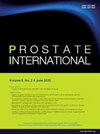探讨罕见性:从全球回顾性分析中了解原发性前列腺弥漫性大b细胞淋巴瘤
IF 2.6
2区 医学
Q2 UROLOGY & NEPHROLOGY
引用次数: 0
摘要
本研究旨在从全球视角对原发性前列腺弥漫性大b细胞淋巴瘤(P-DLBCL-P)病例进行综合分析,了解该疾病的特点、治疗反应和预后。通过这样做,我们寻求建立一个有价值的参考临床管理这种罕见的恶性肿瘤。材料与方法本研究利用PubMed、Scopus等英文数据库以及万方数据、中国国家知识基础设施中文数据库,对全球范围内报道的P-DLBCL-P病例进行回顾性分析,收集患者的临床病理信息、治疗方式、预后,并采用Kaplan-Meier法进行生存分析。结果本研究纳入了68例患者。90.63%的病例出现下尿路症状。此外,89.5%的患者显示前列腺特异性抗原水平低于4 ng/mL的阈值。前列腺活检是最常用的方法,占52.38%,其次是经尿道前列腺切除术,占33.33%。约33.90%诊断为前列腺淋巴瘤的患者经历了IV期疾病,膀胱或输尿管是最常受累的器官(53.33%)。外科手术与无法控制的出血风险升高有关。值得注意的是,化疗显示出积极的治疗反应,完全缓解率为50.94%,部分缓解率为28.30%。随后的随访研究显示1年生存率为73.08%,3年生存率为65.38%。结论P-DLBCL-P的症状往往不典型,导致许多患者在疾病的后期才被诊断出来。通过对全球病例的研究,我们证实了利妥昔单抗-环磷酰胺-阿霉素-长春新碱-强的松方案作为首选治疗方案的有效性。手术干预通常仅用于诊断目的或缓解器官阻塞。本文章由计算机程序翻译,如有差异,请以英文原文为准。
Exploring the rarity: insights into primary diffuse large B-cell lymphoma of the prostate from a global retrospective analysis
Background
The purpose of this study is to comprehensively analyze cases of primary diffuse large B-cell lymphoma of the prostate (P-DLBCL-P) from a global perspective, aiming to understand the disease's characteristics, treatment responses, and outcomes. By doing so, we seek to establish a valuable reference for the clinical management of this rare malignancy.
Materials and methods
This study conducted a retrospective review of P-DLBCL-P cases reported worldwide, using various online databases, including PubMed, Scopus, and other English databases, as well as WanFang Data and China National Knowledge Infrastructure in Chinese, collecting clinical pathology information, treatment modalities, and prognosis of patients, and conducted survival analysis using the Kaplan-Meier method.
Results
A cohort comprising 68 patients was enrolled in this study. Lower urinary tract symptoms were prevalent in 90.63% of cases. Furthermore, 89.5% of patients exhibited prostate-specific antigen levels below the threshold of 4 ng/mL. Prostate biopsy was the most commonly used method, accounting for 52.38% of cases, followed by transurethral resection of the prostate at 33.33%. Approximately 33.90% of patients diagnosed with prostate lymphoma experienced stage IV disease, with the bladder or ureter being the organs most frequently involved (53.33%). Surgical procedures were associated with an elevated risk of uncontrollable hemorrhage. Notably, chemotherapy demonstrated a positive therapeutic response, resulting in a complete remission rate of 50.94% and a partial remission rate of 28.30%. A subsequent follow-up study revealed a 1-year survival rate of 73.08% and a 3-year survival rate of 65.38%.
Conclusions
The symptoms of P-DLBCL-P are often atypical, leading to many patients being diagnosed at a later stage of the disease. Through a global study of cases, we have confirmed the efficacy of the rituximab–cyclophosphamide–adriamycin–vincristine–prednisone regimen as the preferred treatment option. Surgical intervention is typically only used for diagnostic purposes or to relieve organ obstruction.
求助全文
通过发布文献求助,成功后即可免费获取论文全文。
去求助
来源期刊

Prostate International
Medicine-Urology
CiteScore
4.40
自引率
26.70%
发文量
40
审稿时长
35 days
期刊介绍:
Prostate International (Prostate Int, PI), the official English-language journal of Asian Pacific Prostate Society (APPS), is an international peer-reviewed academic journal dedicated to basic and clinical studies on prostate cancer, benign prostatic hyperplasia, prostatitis, and ...
 求助内容:
求助内容: 应助结果提醒方式:
应助结果提醒方式:


